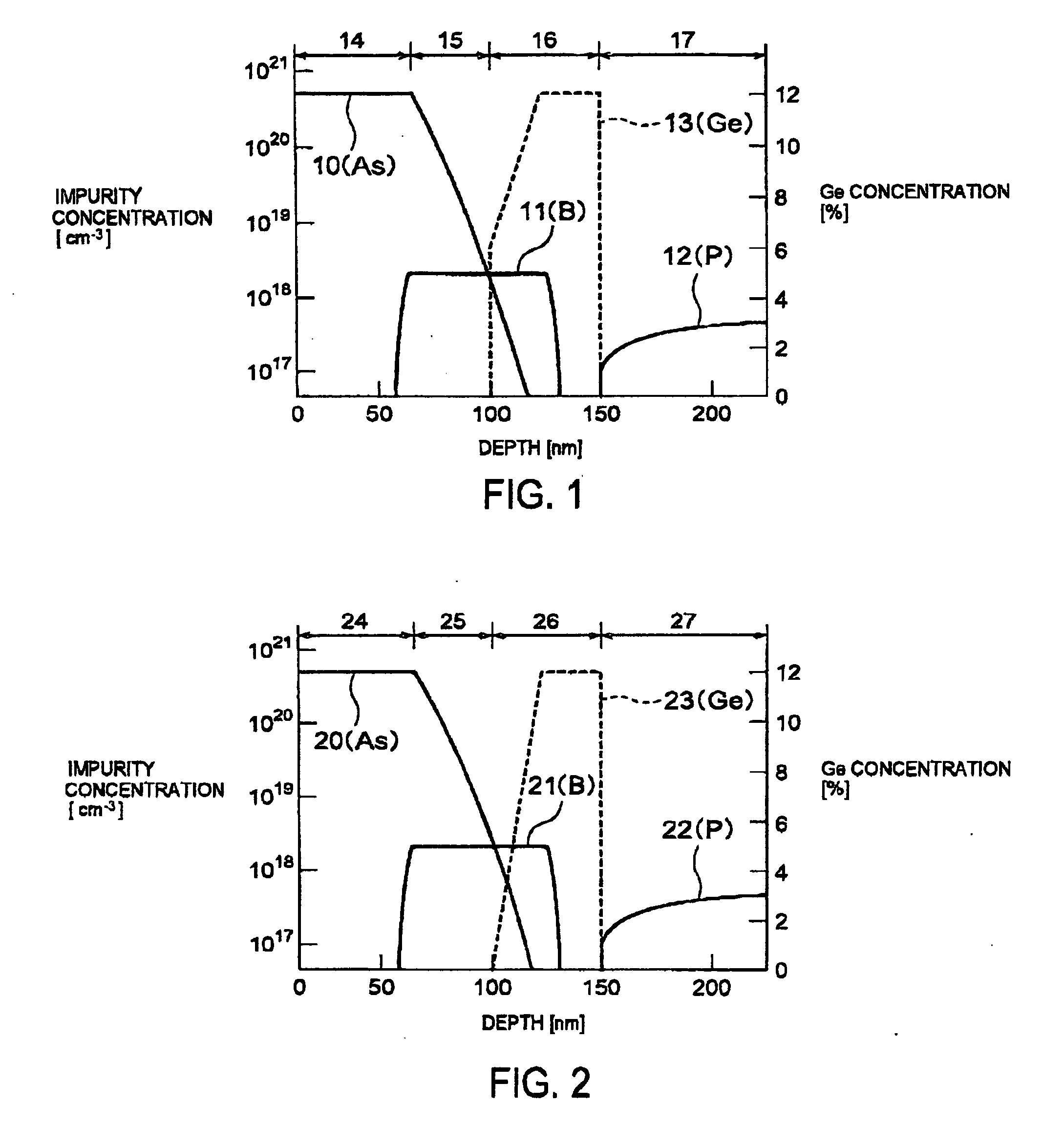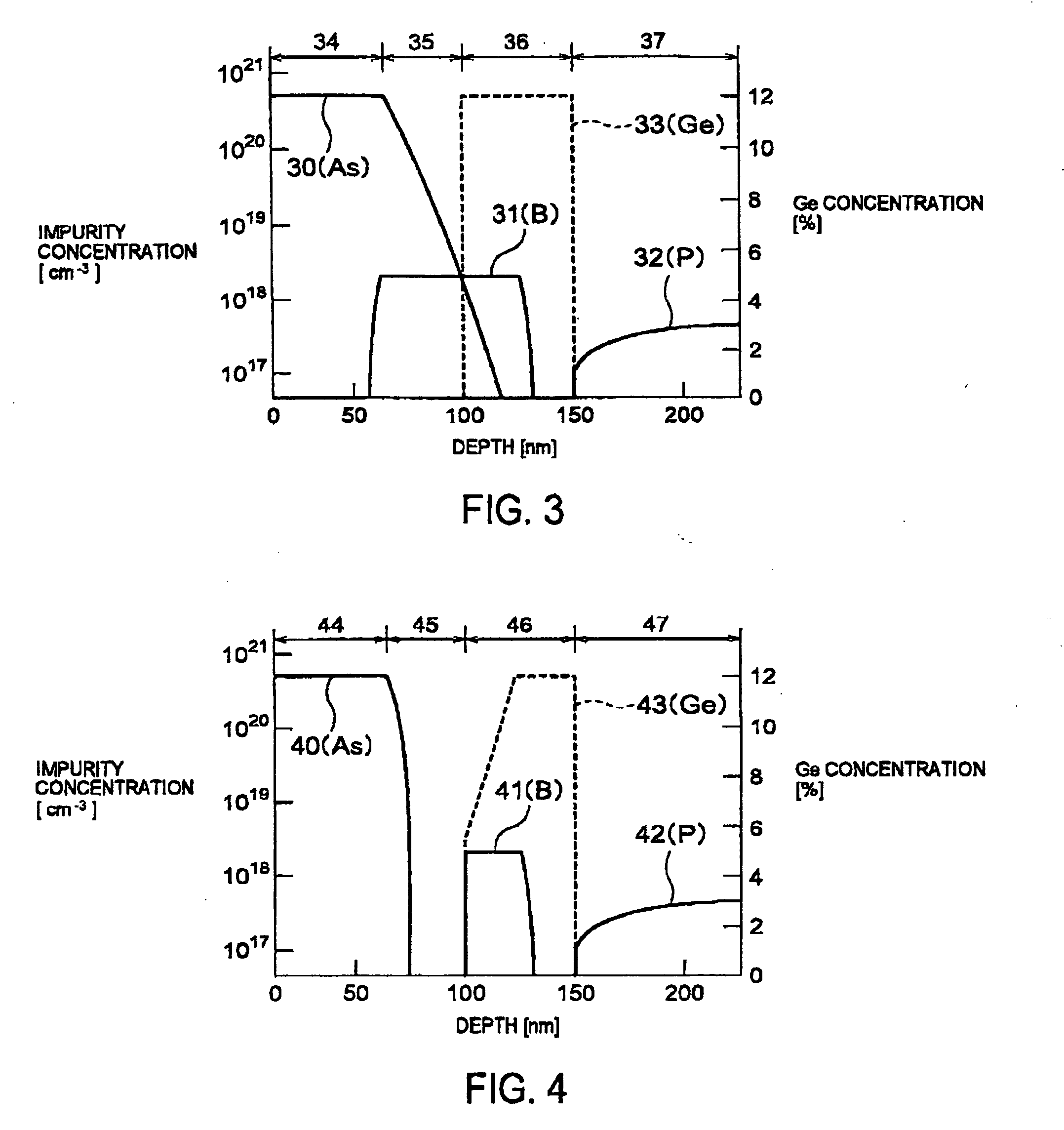Biolar transistor
a transistor and biolar technology, applied in the field of biolar transistors, can solve problems such as practicability difficulties in manufacturing
- Summary
- Abstract
- Description
- Claims
- Application Information
AI Technical Summary
Benefits of technology
Problems solved by technology
Method used
Image
Examples
example 2
[0058] A bipolar transistor according to a second example of the present invention will be described with reference to FIG. 11. FIG. 11 shows the distributions of the impurity concentration and the composition ratio of Ge in the depth direction of the bipolar transistor according to the second example. In FIG. 11, a first solid line 110 indicates a concentration of arsenic, while arsenic is a dopant in an n-type emitter. A second solid line 111 indicates a concentration of boron, while boron is a dopant in a p-type base. A third solid line 112 indicates a concentration of phosphorus, while phosphorus in a dopant in an n-type collector. A broken line 113 indicates a composition ratio of Ge. A first double-headed arrow 114 indicates an emitter poly-Si region. A second double-headed arrow 115 indicates a single crystal Si region (non-doped Si region). The single crystal Si region is non-doped in an As-depo state, and finally a part thereof becomes of the n-type because of diffusion of ...
example 3
[0060] A bipolar transistor according to a third example of the present invention will be described with reference to FIG. 12. FIG. 12 shows the distributions of the impurity concentration and the composition ratio of Ge in the depth direction of the bipolar transistor according to the third example. In FIG. 12, a first solid line 120 indicates a concentration of arsenic, while arsenic is a dopant in an n-type emitter. A second solid line 121 indicates a concentration of boron, while boron is a dopant in a p-type base. A third solid line 122 indicates a concentration of phosphorus, while phosphorus is a dopant in an n-type collector. A broken line 123 indicates a composition ratio of Ge. A first double-headed arrow 124 indicates an emitter poly-Si region. A second double-headed arrow 125 indicates a single crystal Si region (a region assumed to be a non-doped Si region). The single crystal Si region is of the p-type having a low impurity concentration in an As-depo state, and finall...
example 4
[0064] A bipolar transistor according to a fourth example of the present invention will be described with reference to FIG. 13. FIG. 13 shows the distributions of the impurity concentration and the composition ratio of Ge in the depth direction of the bipolar transistor according to the fourth example. In FIG. 13, a first solid line 130 indicates a concentration of arsenic, while arsenic is a dopant in an n-type emitter. A second solid line 131 indicates a concentration of boron, while boron is a dopant in a p-type base. A third solid line 132 indicates a concentration of phosphorus, while phosphorus in a dopant in an n-type collector. A broken line 133 indicates a composition ratio of Ge. A first double-headed arrow 134 indicates an emitter poly-Si region. A second double-headed arrow 135 indicates a single crystal Si region (a region assumed to be a non-doped Si region). The single crystal Si region is non-doped in an As-depo state, and finally becomes of the n-type because of dif...
PUM
 Login to View More
Login to View More Abstract
Description
Claims
Application Information
 Login to View More
Login to View More - R&D
- Intellectual Property
- Life Sciences
- Materials
- Tech Scout
- Unparalleled Data Quality
- Higher Quality Content
- 60% Fewer Hallucinations
Browse by: Latest US Patents, China's latest patents, Technical Efficacy Thesaurus, Application Domain, Technology Topic, Popular Technical Reports.
© 2025 PatSnap. All rights reserved.Legal|Privacy policy|Modern Slavery Act Transparency Statement|Sitemap|About US| Contact US: help@patsnap.com



